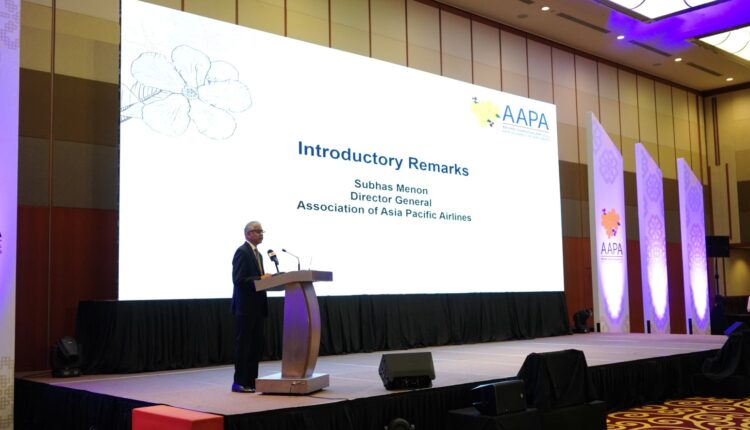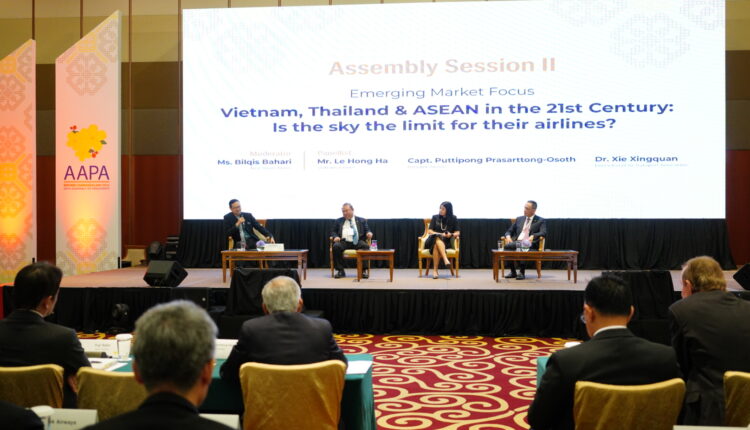
Leaders of the Association of Asia Pacific Airlines (AAPA), gathered for its 68th Assembly of Presidents in Brunei Darussalam on 12th and 13th November to discuss the future of aviation in the region.
Discussing the theme Jetting into 2050: Future Proofing Asian Aviation, airline leaders expressed their optimism as regional air travel and cargo growth continues to surpass the global industry’s growth, while load factors remain steadfastly strong.
Reflecting the collective priorities and shared resolve of Asian airline leaders, the Assembly of Presidents passed a series of resolutions during the event.
Relevant decisions pertained to sustainability, aviation safety, and the streamlining of regulations.
A commitment to sustainability
Airlines are firmly committed to reducing their carbon footprint. With extreme weather events on the rise, airline leaders are only too aware of the risks to aviation safety from climate change.
With Sustainable Aviation Fuel (SAF) in short supply, AAPA believes that a multi-prong strategy in line with the ICAO net zero emissions reduction roadmap, is critical to meeting the industry’s net zero emissions target.
The Assembly passed a resolution calling on governments, suppliers, air navigation service providers and airlines to deploy all aspects of the ICAO roadmap, namely SAF, breakthrough technology, CORSIA offsets, and operational efficiency, in pursuing the net zero emissions by 2050 goal.
In particular, SAF produced by co-processing sustainable feedstock together with crude fossil fuel in conventional aviation fuel refineries, is a cost-effective way to stimulate SAF supply.
Airlines and fuel suppliers could give impetus to the transition to SAF with co-processed SAF being made available at airports immediately.
AAPA director-general Subhas Menon said of this: “Every new generation of aircraft and engine delivers 15 to 20 percent more fuel efficiency. The acceleration of plans for carbon-friendly aircraft and propulsion systems is an effective pathway to the common goal of net zero carbon emissions by 2050, starting with short-haul aircraft that currently account for some 28 percent of industry emissions. With delays in the delivery of new generation aircraft, airlines are extending the use of older equipment. A strategy that prioritises technology alongside SAF, is a surer route to carbon neutrality, than one over-reliant on SAF.”

Emphasising safety
Aviation safety remains the number one priority of all airlines.
The Assembly adopted a resolution calling for civil aviation authorities, aviation safety agencies and airlines to work closely together to share best practices through data analysis, to mitigate risks such as the loss of control in-flight.
The resolution also called on all stakeholders to support the adoption of safety measures that address the most critical risk categories identified in the Asia Pacific region.
Menon said of this: “The Assembly welcomed the results and recommendations of the safety culture survey conducted by the Flight Safety Foundation, as aviation safety is about promoting a proactive safety culture, leveraging data and sharing best practices to improve performance.”

What price disruptions?
The Assembly of Presidents also acknowledged that supply chain disruptions and air space closures are leading to more flight diversions, delays, and cancellations, while also inhibiting future growth.
Such issues, including component failures and labour shortages were impinging on schedule reliability.
Conflicts such as the Russia-Ukraine war and in the Middle East have resulted in airspace closures, exacerbating the situation. Knee-jerk reactions by some governments target only the symptoms of failure, while burdening airlines with more cost and complexity.
A third resolution was passed calling on governments to refrain from introducing unilateral measures that would disproportionately inconvenience the travelling public and increase the cost burden on the airline industry, while achieving limited benefits.
There needed to be greater recognition of the value of aviation to the global economy, and closer collaboration amongst governments, industry, and service providers, to streamline protocols for international travel.
Menon concluded: “The outlook for the region’s airlines is broadly positive, given the sustained demand for air travel and strong rebound in trade activity. It is a remarkable recovery on key metrics, considering that air transport ground to an almost complete standstill for two years during the COVID-19 pandemic in 2020. This is also a timely testament to the industry’s endurance and longevity as we commemorate the 80thAnniversary of the ICAO Chicago Convention in 2024. By keeping the travelling public and the economies we serve at the core of our strategy, the industry is well positioned to tackle upcoming challenges and pursue sustainable growth in the years ahead.”
